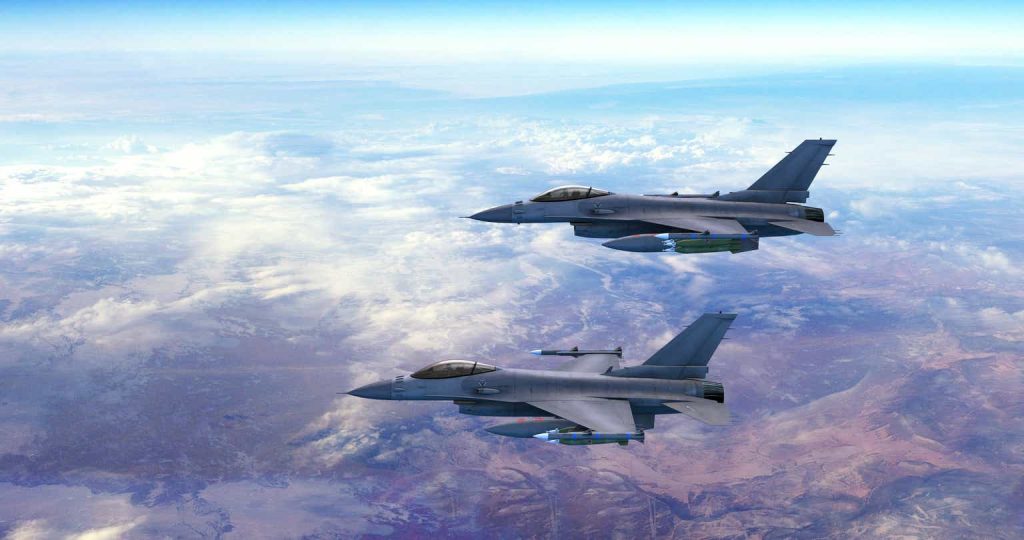In the world of dividend investing, where stability and consistent returns are prized above all else, few sectors shine as brightly as aerospace and defense. Companies such as Lockheed Martin Corp (LMT), General Dynamics Corp (GD), and RTX Corp (RTX) have not only established themselves as formidable guardians of national security but have also emerged as dividend champions.
Aerospace and defense stocks represent a unique corner of the investment landscape. These companies play a pivotal role in safeguarding nations by providing essential products and services for military and defense purposes. From advanced fighter jets and naval systems to cutting-edge technology solutions in cybersecurity and intelligence, their offerings are as diverse as they are vital. What sets them apart is their dual mandate-serving both government and commercial markets. This diversity not only bolsters their financial stability but also ensures a level of resilience that few other sectors can match.
What makes aerospace and defense companies especially attractive to income-seeking investors is their commitment to dividends. They have earned a reputation for reliably rewarding shareholders with consistent dividend payments, even in the face of economic uncertainty. In addition to their dividend prowess, these companies have consistently generated robust stock price appreciation.
In today’s post we will explore why these 3 defense contractors are among the crème de la crème of dividend-paying companies, why they deserve a coveted spot in your investment portfolio, and how they have consistently outperformed other dividend stocks.
#1 Lockheed Martin Corp (LMT)
Lockheed Martin is a prominent security and aerospace company with a diverse portfolio. The company operates across four key segments: Aeronautics, Missiles and Fire Control, Rotary and Mission Systems, and Space. Within these segments, Lockheed Martin offers a wide range of products and services, including combat and air mobility aircraft, missile defense systems, unmanned air vehicles, and space transportation systems.
Lockheed Martin Corp stands as a stalwart in the aerospace and defense industry, renowned for its commitment to shareholders through consistent dividend growth. Currently, the company offers a quarterly dividend of $3.00 per share, translating into an annual dividend of $12.00 per share, resulting in an impressive annual dividend yield of 2.68%, considering the current stock price. Notably, Lockheed Martin has maintained its track record of dividend increases for the last 20 consecutive years, underlining its dedication to providing reliable income to investors. Over the past five years, the company’s dividends have experienced a steady compound annual growth rate (CAGR) of 8.45%. Additionally, Lockheed Martin boasts a reasonable dividend payout ratio of 42.42%, indicating financial stability and room for further dividend growth.
The company’s recent Q2 results underscore its financial strength and growth trajectory. Lockheed Martin reported net sales of $16.7 billion in the second quarter of 2023, representing an impressive 8% year-over-year increase. Net earnings for the same period reached $1.7 billion, or $6.63 per share, compared to $309 million, or $1.16 per share, in the second quarter of 2022. Furthermore, the company reported cash from operations of $1.1 billion and free cash flow of $771 million during Q2 2023. This robust financial performance allowed Lockheed Martin to return $1.5 billion to shareholders through dividends and share repurchases.
CEO Jim Taiclet expressed confidence in the company’s prospects, citing a record backlog of $158 billion and strong orders for key programs like the F-35. Lockheed Martin’s dynamic capital allocation strategy and focus on advanced technologies position it well for continued growth. As a result, the company raised its outlook for 2023, with expectations of higher sales, segment operating profit, and earnings per share.
In recent developments, Lockheed Martin’s subsidiary, Sikorsky Aircraft Corp., secured a substantial $2.77 billion Navy contract modification for the production of CH-53K aircraft, demonstrating the company’s ongoing commitment to delivering cutting-edge aerospace solutions. Furthermore, the Space Development Agency awarded Lockheed Martin a contract worth approximately $816 million for 36 Tranche 2 Transport Layer Beta satellites.
Lockheed Martin Corp continues to exhibit strong fundamentals that make it an attractive investment. With a forward price-to-earnings (P/E) multiple of 16.51, which is below the sector median of 18.10, LMT appears undervalued in the current market. While the consensus 12-month price target among Wall Street analysts stands at $494, representing a potential upside of 10.5%, it’s worth noting that Lockheed Martin’s history of consistent dividend growth, combined with its strong financial performance and diverse portfolio, suggests it has the potential to outperform these estimates. Given its reasonable valuation and impressive track record, LMT remains a bullish prospect for investors.
#2 General Dynamics Corp (GD)
General Dynamics Corp is another prominent figure in the aerospace and defense sector, distinguished for its steadfast commitment to shareholders through an impressive track record of dividend growth. The company operates on a global scale, with operations segmented into four key divisions: Aerospace, Marine Systems, Combat Systems, and Technologies.
Among recent developments, General Dynamics Information Technology, a subsidiary of GD, secured two recompete task orders collectively valued at $320 million from the U.S. Department of State’s Bureau of Consular Affairs. These contracts, comprising the Andean South America task order ($200 million) and a task order for providing services in Brazil ($120 million), further strengthen GD’s global consular services support for the State Department. In addition to these contracts, GD celebrated a significant labor agreement that augurs well for its future endeavors. Bath Iron Works, a subsidiary of General Dynamics, approved a new three-year labor contract, avoiding a repeat of the 2020 strike that resulted in significant delays in delivering ships. This new contract, ratified by Machinists Union Local S6, which represents around 4,200 production workers, includes substantial pay raises, ranging from 9.6% in the first year to 5% in the second year and 4% in the third year.
With a dividend history that spans 31 consecutive years of increases, GD currently offers investors a quarterly dividend of $1.32 per share, translating to an annual dividend of $5.28 per share and an alluring annual dividend yield of 2.33%, taking into account the current stock price. Over the last five years, GD’s dividends have exhibited a robust compound annual growth rate (CAGR) of 7.83%, showcasing the company’s dedication to providing reliable income to its investors. GD maintains a sound financial standing, reflected in its prudent dividend payout ratio of 42.36%, indicating financial stability and ample room for further dividend expansion.
From a financial standpoint, General Dynamics Corporation reported net earnings of $744 million in Q2 2023, driven by robust revenue of $10.2 billion, marking an impressive 10.5% year-over-year increase. Despite ongoing supply chain challenges in several units, GD’s businesses demonstrated solid momentum, achieving the highest-ever revenue for a mid-year quarter and establishing a record-high backlog of $91.4 billion. This backlog not only highlights GD’s prowess in securing new business but also signals strong demand for its products and services.
General Dynamics Corp is poised as an appealing investment opportunity within the aerospace and defense sector. Trading at a forward P/E of 17.89, which is below the sector median of 20.57, GD appears attractively priced. Although its forward EV/EBITDA multiple is slightly above the sector average, indicating a premium valuation in that regard, it’s important to consider the optimism among Wall Street analysts, with 8 out of 10 analysts giving the stock a ‘Buy’ rating. This strong endorsement from analysts reflects confidence in GD’s ability to deliver solid returns.
#3 RTX Corporation (RTX)
Our third pick, RTX Corporation, formerly known as Raytheon Technologies, is another stalwart in the aerospace and defense sector, offering a wide range of systems and services to commercial, military, and government customers worldwide. The company operates through four key segments: Collins Aerospace, Pratt & Whitney, Raytheon Intelligence & Space, and Raytheon Missiles & Defense. This diversified portfolio positions RTX as a major player in the industry.
One of the standout aspects of RTX for investors is its consistent commitment to dividend growth. Currently, the company pays a quarterly dividend of $0.59 per share, resulting in an annual dividend of $2.36 per share. Considering the current stock price, this translates into an appealing annual dividend yield of 2.74%. RTX has a remarkable track record of increasing its dividends for 29 consecutive years. However, it’s worth noting that RTX’s dividend growth, with a five-year compound annual growth rate (CAGR) of 5.29%, is slightly lower compared to the other two companies mentioned in this article.
In the second quarter of 2023, RTX showcased its financial strength and growth potential. The company reported impressive results, with sales reaching $18.3 billion, marking a significant 12% year-over-year increase. GAAP EPS from continuing operations amounted to $0.90, reflecting a 2% increase over the previous year. Adjusted EPS stood at $1.29, showing an even more substantial 11% improvement. RTX also demonstrated robust operating cash flow of $719 million and a free cash flow of $193 million during this period.
RTX’s commitment to returning value to shareholders is evident in its share repurchase program, which saw the company repurchasing $596 million of its shares during the quarter. Moreover, RTX’s backlog of $185 billion, comprising $73 billion in defense contracts and $112 billion in commercial contracts, highlights the strong demand for its products and services. The company’s strategic outlook includes increased sales expectations and adjusted EPS, reflecting its positive momentum.
In recent contract wins, RTX Corporation has been making substantial strides. On August 31, 2023, Raytheon Missile Systems, a subsidiary of RTX, was awarded a $276.54 million modification contract for the procurement of 155 mm projectiles.
Furthermore, it’s important to note that RTX has faced challenges related to engine recalls, particularly affecting its Pratt & Whitney division. A rare condition in powder metal used for certain engine parts has necessitated accelerated fleet inspections, impacting airlines globally. Despite these challenges, RTX’s stock remains resilient.
With a forward P/E multiple of 17.21 and a forward EV/EBITDA multiple of 12.25, RTX is trading in line with or below sector medians, indicating a reasonable valuation. Furthermore, considering its historical average P/E of 24.96, RTX appears undervalued based on its current valuation. Wall Street analysts are generally optimistic about the stock, with 8 out of 14 analysts rating it as a ‘Buy’ and the remainder opting for a ‘Hold’ rating. This positive sentiment underscores the potential for RTX to perform well. With its attractive valuation and analyst support, RTX remains a compelling choice for investors seeking a dividend champion with growth potential.
Investor Takeaway
All three defense contractors are fantastic companies that are all seeing great demand. Higher demand due to Russia’s invasion of Ukraine has put many other countries on notice to bolster their military equipment, which is evidenced based on the companies backlogs. This benefits all defense contractors across the board.
All three contractors we looked at today, LMT, GD, and RTX are all trading at compelling valuations. RTX is definitely the highest risk of the three due to the uncertainty regarding the engine issues they ran into in the most recent quarter. Investors seem to have overreacted upon the announcement, so it could provide a great buying opportunity for long-term investors willing to wait to see the true extent of the issue.
Lastly, all three companies pay safe and growing dividends, which is always great to see.
COMMENT BELOW: Which of these three defense contractors do you see the MOST opportunity in right now?
Disclosure: This article is intended to provide information to interested parties. I have no knowledge of your individual goals as an investor, and I ask that you complete your own due diligence before purchasing any stocks mentioned or recommended.
Read the full article here















